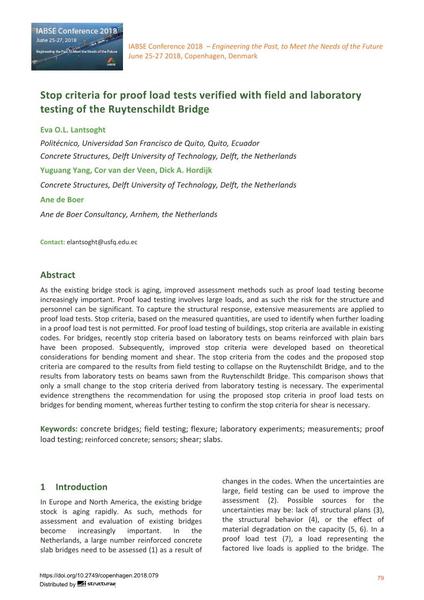Stop Criteria for Proof Load Tests Verified with Field and Laboratory Testing of the Ruytenschildt Bridge

|
|
|||||||||||
Bibliographic Details
| Author(s): |
Eva O. L. Lantsoght
Yuguang Yang Cor van der Veen (Concrete Structures, Delft University of Technology, Delft, the Netherlands) Dick A. Hordijk (Concrete Structures, Delft University of Technology, Delft, the Netherlands) Ane de Boer (Ane de Boer Consultancy, Arnhem, the Netherlands) |
||||
|---|---|---|---|---|---|
| Medium: | conference paper | ||||
| Language(s): | English | ||||
| Conference: | IABSE Conference: Engineering the Past, to Meet the Needs of the Future, Copenhagen, Denmark, 25-27 June 2018 | ||||
| Published in: | IABSE Conference Copenhagen 2018 | ||||
|
|||||
| Page(s): | 79-86 | ||||
| Total no. of pages: | 8 | ||||
| DOI: | 10.2749/copenhagen.2018.079 | ||||
| Abstract: | As the existing bridge stock is aging, improved assessment methods such as proof load testing become increasingly important. Proof load testing involves large loads, and as such the risk for the structure and personnel can be significant. To capture the structural response, extensive measurements are applied to proof load tests. Stop criteria, based on the measured quantities, are used to identify when further loading in a proof load test is not permitted. For proof load testing of buildings, stop criteria are available in existing codes. For bridges, recently stop criteria based on laboratory tests on beams reinforced with plain bars have been proposed. Subsequently, improved stop criteria were developed based on theoretical considerations for bending moment and shear. The stop criteria from the codes and the proposed stop criteria are compared to the results from field testing to collapse on the Ruytenschildt Bridge, and to the results from laboratory tests on beams sawn from the Ruytenschildt Bridge. This comparison shows that only a small change to the stop criteria derived from laboratory testing is necessary. The experimental evidence strengthens the recommendation for using the proposed stop criteria in proof load tests on bridges for bending moment, whereas further testing to confirm the stop criteria for shear is necessary. | ||||
| Keywords: |
slabs reinforced concrete shear concrete bridges sensor flexure field testing laboratory experiments measurements proof
load testing
|
||||
